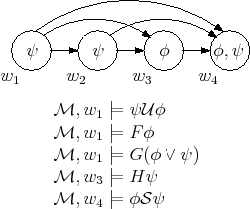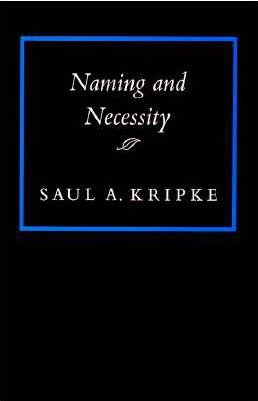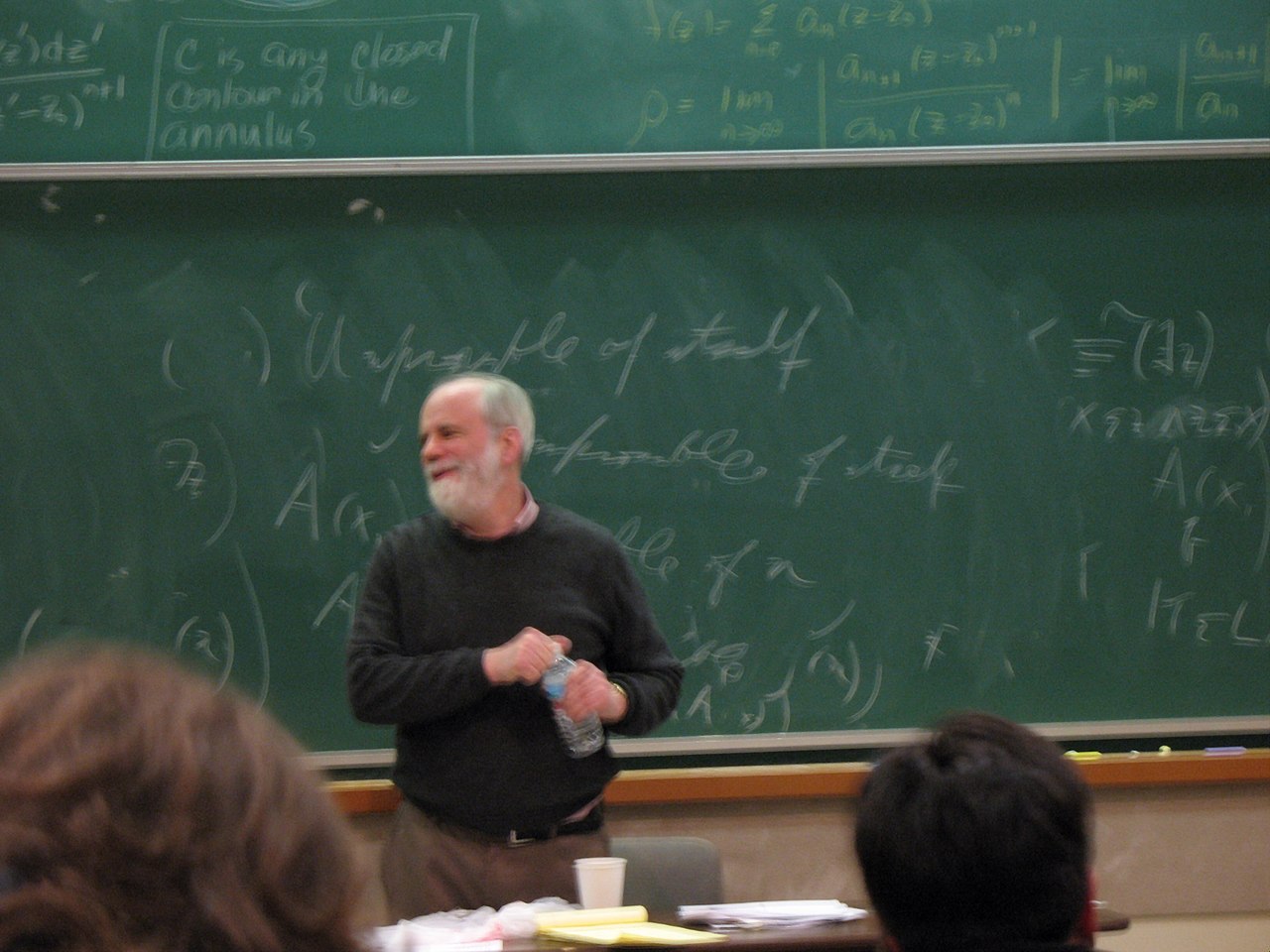
ソール・クリプキと名指し
Saul Aaron Kripke, 1940-2022

☆ ソール・アーロン・クリプキ(/ˈkrɪpki/、1940年11月13日 - 2022年9月15日)は、アメリカの分析哲学者、論理学者である。ニューヨーク市立大学大学院センターの哲学の特別教授であり、プリンストン大学の名誉 教授でもあった。1960年代から亡くなるまで、数学的・様相論理、言語哲学、数学、形而上学、認識論、再帰理論など、さまざまな分野において中心的な存 在であった。 クリプキは論理学、特に様相論理に影響力のある独創的な貢献をした。彼の主な貢献は、可能世界論理のセマンティクスであり、現在はクリプキ・セマンティク スと呼ばれている。[6] 2001年には論理学と哲学のショック賞を受賞した。 クリプキはまた、論理実証主義の衰退後に形而上学と本質論の復興に一役買った。彼は、必然性はア・プリオリに認識される認識論的概念とは異なる形而上学的 概念であり、水はH2Oであるというような、ア・ポステリオリに認識される必然的真理が存在すると主張した。1970年にプリンストン大学で行われた一連 の講義は、1980年に『命名と必然性』として書籍化され、20世紀の最も重要な哲学書の一つとされている。この本では、あらゆる世界において同一の対象 を指し示す(選び出す、示す、参照する)厳格な指示子としての名称の概念が紹介され、記述と対比されている。また、クリプキは、ゴットロープ・フレーゲの 「意味」の概念やバートランド・ラッセルの記述理論に見られる記述主義理論に異議を唱え、クリプキの因果参照理論を確立した。クリプキは、20世紀後半の 他の偉大な哲学者で論理実証主義を否定する立場にあるW. V. O. クワインと対立する立場にあると見られることが多い。クワインは本質論と様相論理を否定した。[7][8] クリプキはまた、ルートヴィヒ・ウィトゲンシュタインの著作を独自の視点で解釈し、「クリプケスタイン」として知られる『ルールと私的言語に関するウィト ゲンシュタイン』を著した。この本には、彼のルールに従う論証、意味に対する懐疑論のパラドックスが含まれている。彼の作品の多くは未出版のままか、テー プ録音や非公開の原稿としてのみ存在している。
| Saul Aaron Kripke
(/ˈkrɪpki/; November 13, 1940 – September 15, 2022) was an American
analytic philosopher and logician. He was Distinguished Professor of
Philosophy at the Graduate Center of the City University of New York
and emeritus professor at Princeton University. From the 1960s until
his death, he was a central figure in a number of fields related to
mathematical and modal logic, philosophy of language and mathematics,
metaphysics, epistemology, and recursion theory. Kripke made influential and original contributions to logic, especially modal logic. His principal contribution is a semantics for modal logic involving possible worlds, now called Kripke semantics.[6] He received the 2001 Schock Prize in Logic and Philosophy. Kripke was also partly responsible for the revival of metaphysics and essentialism after the decline of logical positivism, claiming necessity is a metaphysical notion distinct from the epistemic notion of a priori, and that there are necessary truths that are known a posteriori, such as that water is H2O. A 1970 Princeton lecture series, published in book form in 1980 as Naming and Necessity, is considered one of the most important philosophical works of the 20th century. It introduced the concept of names as rigid designators, designating (picking out, denoting, referring to) the same object in every possible world, as contrasted with descriptions. It also established Kripke's causal theory of reference, disputing the descriptivist theory found in Gottlob Frege's concept of sense and Bertrand Russell's theory of descriptions. Kripke is often seen in opposition to the other great late-20th-century philosopher to eschew logical positivism: W. V. O. Quine. Quine rejected essentialism and modal logic.[7][8] Kripke also gave an original reading of Ludwig Wittgenstein, known as "Kripkenstein", in his Wittgenstein on Rules and Private Language. The book contains his rule-following argument, a paradox for skepticism about meaning. Much of his work remains unpublished or exists only as tape recordings and privately circulated manuscripts. |
ソール・アーロン・クリプキ(/ˈkrɪpki/、1940年11月
13日 -
2022年9月15日)は、アメリカの分析哲学者、論理学者である。ニューヨーク市立大学大学院センターの哲学の特別教授であり、プリンストン大学の名誉
教授でもあった。1960年代から亡くなるまで、数学的・様相論理、言語哲学、数学、形而上学、認識論、再帰理論など、さまざまな分野において中心的な存
在であった。 クリプキは論理学、特に様相論理に影響力のある独創的な貢献をした。彼の主な貢献は、可能世界論理のセマンティクスであり、現在はクリプキ・セマンティク スと呼ばれている。[6] 2001年には論理学と哲学のショック賞を受賞した。 クリプキはまた、論理実証主義の衰退後に形而上学と本質論の復興に一役買った。彼は、必然性はア・プリオリに認識される認識論的概念とは異なる形而上学的 概念であり、水はH2Oであるというような、ア・ポステリオリに認識される必然的真理が存在すると主張した。1970年にプリンストン大学で行われた一連 の講義は、1980年に『命名と必然性』として書籍化され、20世紀の最も重要な哲学書の一つとされている。この本では、あらゆる世界において同一の対象 を指し示す(選び出す、示す、参照する)厳格な指示子としての名称の概念が紹介され、記述と対比されている。また、クリプキは、ゴットロープ・フレーゲの 「意味」の概念やバートランド・ラッセルの記述理論に見られる記述主義理論に異議を唱え、クリプキの因果参照理論を確立した。クリプキは、20世紀後半の 他の偉大な哲学者で論理実証主義を否定する立場にあるW. V. O. クワインと対立する立場にあると見られることが多い。クワインは本質論と様相論理を否定した。[7][8] クリプキはまた、ルートヴィヒ・ウィトゲンシュタインの著作を独自の視点で解釈し、「クリプケスタイン」として知られる『ルールと私的言語に関するウィト ゲンシュタイン』を著した。この本には、彼のルールに従う論証、意味に対する懐疑論のパラドックスが含まれている。彼の作品の多くは未出版のままか、テー プ録音や非公開の原稿としてのみ存在している。 |
| Life and career Saul Kripke was the oldest of three children born to Dorothy K. Kripke and Myer S. Kripke.[9] His father was the leader of Beth El Synagogue, the only Conservative congregation in Omaha, Nebraska; his mother wrote Jewish educational books for children. Saul and his two sisters, Madeline and Netta, attended Dundee Grade School and Omaha Central High School. Kripke was labeled a prodigy, teaching himself Ancient Hebrew by the age of six, reading Shakespeare's complete works by nine, and mastering the works of Descartes and complex mathematical problems before finishing elementary school.[10][11] He wrote his first completeness theorem in modal logic at 17, and had it published a year later. After graduating from high school in 1958, Kripke attended Harvard University and graduated summa cum laude in 1962 with a bachelor's degree in mathematics. During his sophomore year at Harvard, he taught a graduate-level logic course at nearby MIT.[12] Upon graduation he received a Fulbright Fellowship, and in 1963 was appointed to the Society of Fellows. Kripke later said, "I wish I could have skipped college. I got to know some interesting people but I can't say I learned anything. I probably would have learned it all anyway just reading on my own."[13] His cousin is Eric Kripke, known for creating the television show The Boys.[14] After briefly teaching at Harvard, Kripke moved in 1968 to Rockefeller University in New York City, where he taught until 1976. In 1978 he took a chaired professorship at Princeton University.[15] In 1988 he received the university's Behrman Award for distinguished achievement in the humanities. In 2002 Kripke began teaching at the CUNY Graduate Center, and in 2003 he was appointed a distinguished professor of philosophy there. Kripke has received honorary degrees from the University of Nebraska, Omaha (1977), Johns Hopkins University (1997), University of Haifa, Israel (1998), and the University of Pennsylvania (2005). He was a member of the American Philosophical Society and an elected Fellow of the American Academy of Arts and Sciences, and in 1985 was a Corresponding Fellow of the British Academy.[16] He won the Schock Prize in Logic and Philosophy in 2001.[17] Kripke was married to philosopher Margaret Gilbert. Kripke died of pancreatic cancer on September 15, 2022, in Plainsboro, New Jersey, at the age of 81.[18][19][20] Work  Example Kripke model for linear temporal logic, a particular modal logic Kripke's contributions to philosophy include: Kripke semantics for modal and related logics, published in several essays beginning in his teens. His 1970 Princeton lectures Naming and Necessity (published in 1972 and 1980), which significantly restructured philosophy of language. His interpretation of Wittgenstein. His theory of truth. He has also contributed to recursion theory (see admissible ordinal and Kripke–Platek set theory). |
生涯と経歴 ソール・クリプキはドロシー・K・クリプキとマイヤー・S・クリプキの間に生まれた3人の子供の長男であった。[9] 父親はネブラスカ州オマハにある唯一の保守派の会衆であるベス・エル・シナゴーグの指導者であり、母親は子供向けのユダヤ教の教育書を執筆していた。ソー ルと2人の姉妹、マデリンとネッタは、ダンディー小学校とオマハ中央高校に通った。クリプキは6歳までに古代ヘブライ語を独学し、9歳までにシェイクスピ ア全集を読み、小学校を卒業する前にデカルトの著作と複雑な数学の問題をマスターしたため、神童と呼ばれた。[10][11] 17歳のときに様相論理における最初の完全性定理を書き、1年後に出版された。1958年に高校を卒業したクリプキはハーバード大学に進学し、1962年 に数学の学士号を取得して最優等(summa cum laude)で卒業した。ハーバード大学2年生の時には、近くのマサチューセッツ工科大学(MIT)で大学院レベルの論理学のコースを教えたこともある。 卒業と同時にフルブライト奨学金を受け、1963年にはフェローシップ会員に任命された。クリプキは後に「大学を中退できたらよかったのに。面白い人たち には出会えたが、何かを学んだとは言えない。おそらくは独学でもすべて学べただろう」と語っている。[13] 彼の従兄弟は、テレビ番組『The Boys』の作者として知られるエリック・クリプキである。[14] ハーバード大学で短期間教鞭をとった後、クリプキは1968年にニューヨーク市のロックフェラー大学に移り、1976年まで教鞭をとった。1978年には プリンストン大学の教授職に就いた。[15] 1988年には、人文科学分野における顕著な功績を称えられ、同大学のベールマン賞を受賞した。2002年、クリプキはCUNY大学院センターで教鞭をと り始め、2003年には同校の哲学の特別教授に任命された。 クリプキは、ネブラスカ大学オマハ校(1977年)、ジョンズ・ホプキンス大学(1997年)、イスラエルのハイファ大学(1998年)、ペンシルベニア 大学(2005年)から名誉学位を授与されている。また、アメリカ哲学協会の会員であり、アメリカ芸術科学アカデミーの選出フェローであり、1985年に は英国学士院の客員研究員であった。[16] 2001年には論理学と哲学のショック賞を受賞している。[17] クリプキは哲学者のマーガレット・ギルバートと結婚していた。 クリプキは2022年9月15日、ニュージャージー州プレインボロにて、膵臓癌のため81歳で死去した。[18][19][20] 作品  例 線形時相論理のためのクリプキモデル、個別様相論理 クリプキの哲学への貢献には以下がある。 様相論理および関連論理のためのクリプキ意味論、10代の頃からいくつかのエッセイで発表。 1970年のプリンストン大学での講義「命名と必然性」(1972年と1980年に出版)は、言語哲学を大幅に再構築した。 ウィトゲンシュタインの解釈。 真理の理論。 また、再帰理論にも貢献している(許容序数とクリプキ=プラテック集合論を参照)。 |
| Modal logic of Saul Kripke (Modal logic) |
様相論理(省略) |
| Naming and Necessity Main article: Naming and Necessity  Cover of Naming and Necessity The three lectures that form Naming and Necessity constitute an attack on the descriptivist theory of names. Kripke attributes variants of descriptivist theories to Frege, Russell, Wittgenstein, and John Searle, among others. According to descriptivist theories, proper names either are synonymous with descriptions, or have their reference determined by virtue of the name's being associated with a description or cluster of descriptions that an object uniquely satisfies. Kripke rejects both these kinds of descriptivism. He gives several examples purporting to render descriptivism implausible as a theory of how names get their references determined (e.g., surely Aristotle could have died at age two and so not satisfied any of the descriptions we associate with his name, but it would seem wrong to deny that he was still Aristotle). As an alternative, Kripke outlined a causal theory of reference, according to which a name refers to an object by virtue of a causal connection with the object as mediated through communities of speakers. He points out that proper names, in contrast to most descriptions, are rigid designators: that is, a proper name refers to the named object in every possible world in which the object exists, while most descriptions designate different objects in different possible worlds. For example, "Richard Nixon" refers to the same person in every possible world in which Nixon exists, while "the person who won the United States presidential election of 1968" could refer to Nixon, Humphrey, or others in different possible worlds. Kripke also raised the prospect of a posteriori necessities—facts that are necessarily true, though they can be known only through empirical investigation. Examples include "Hesperus is Phosphorus", "Cicero is Tully", "Water is H2O", and other identity claims where two names refer to the same object. According to Kripke, the Kantian distinctions between analytic and synthetic, a priori and a posteriori, and contingent and necessary do not map onto one another. Rather, analytic/synthetic is a semantic distinction, a priori/a posteriori is an epistemic distinction, and contingent/necessary is a metaphysical distinction. Finally, Kripke gave an argument against identity materialism in the philosophy of mind, the view that every mental particular is identical with some physical particular. Kripke argued that the only way to defend this identity is as an a posteriori necessary identity, but that such an identity—e.g., that pain is C-fibers firing—could not be necessary, given the (clearly conceivable) possibility that pain could be separate from the firing of C-fibers, or the firing of C-fibers be separate from pain. (Similar arguments have since been made by David Chalmers.[24]) In any event, the psychophysical identity theorist, according to Kripke, incurs a dialectical obligation to explain the apparent logical possibility of these circumstances, since according to such theorists they should be impossible. Kripke delivered the John Locke Lectures in philosophy at Oxford in 1973. Titled Reference and Existence, they were in many respects a continuation of Naming and Necessity, and deal with the subjects of fictional names and perceptual error. In 2013 Oxford University Press published the lectures as a book, also titled Reference and Existence. In a 1995 paper, philosopher Quentin Smith argued that key concepts in Kripke's new theory of reference originated in the work of Ruth Barcan Marcus more than a decade earlier.[25] Smith identified six significant ideas in the New Theory that he claimed Marcus had developed: (1) that proper names are direct references that do not consist of contained definitions; (2) that while one can single out a single thing by a description, this description is not equivalent to a proper name of this thing; (3) the modal argument that proper names are directly referential, and not disguised descriptions; (4) a formal modal logic proof of the necessity of identity; (5) the concept of a rigid designator, though Kripke coined that term; and (6) a posteriori identity. Smith argued that Kripke failed to understand Marcus's theory at the time but later adopted many of its key conceptual themes in his New Theory of Reference. Other scholars have subsequently offered detailed responses arguing that no plagiarism occurred.[26][27] |
命名と必然性 詳細は「命名と必然性」を参照  『命名と必然性』の表紙 『命名と必然性』を構成する3つの講義は、名称の記述主義理論に対する攻撃である。クリプキは、記述主義理論のバリエーションを、フリーゲ、ラッセル、 ウィトゲンシュタイン、ジョン・サールなどに帰している。記述主義理論によると、固有名詞は記述と同義であるか、あるいは、固有名詞が、ある対象が唯一満 たす記述または記述群と関連付けられているという事実によって参照が決定される。クリプキは、この2つの記述説をともに否定している。彼は、固有名詞が何 を指し示すかが決定される理論として、記述説はありえないとするいくつかの例を挙げている(例えば、アリストテレスは確かに2歳で死ぬ可能性もあり、その 場合、彼の名前と関連付けられる記述のいずれにも当てはまらないが、彼が依然としてアリストテレスであったことを否定するのは間違いである)。 代わりに、クリプキは「参照の因果理論」を概説し、それによれば、名前は話し手集団を仲介する対象との因果関係によって対象を参照する。 クリプキは固有名詞は、ほとんどの記述とは対照的に、硬直した指示子であると指摘している。つまり、固有名詞は対象が存在するあらゆる可能世界において、 その対象を参照するが、ほとんどの記述は異なる可能世界において異なる対象を指示する。例えば、「リチャード・ニクソン」という固有名詞は、ニクソンが存 在するあらゆる世界において同一人物を指すが、「1968年のアメリカ大統領選挙で当選した人物」は、異なる世界ではニクソン、ハンプトン、あるいは他の 人物を指す可能性がある。 クリプキはまた、ア・ポステリオリな必然性、すなわち、経験的調査によってのみ知ることができるが、必然的に真である事実の可能性についても言及してい る。 例としては、「ヘスペルスはリンである」、「キケロはタリーである」、「水はH2Oである」、そして2つの名称が同一の対象を指す同一性主張などがある。 クリプキによると、カントの分析的・総合的、ア・プリオリに・ア・ポステリオリな、偶発的・必然的という区別は、互いに一致しない。むしろ、分析的・総合 的は意味論的な区別であり、ア・プリオリに・ア・ポステリオリなは認識論的な区別であり、偶発的・必然的は形而上学的な区別である。 最後に、クリプキは、心の哲学における同一性唯物論、すなわち、あらゆる精神的な特質は、何らかの物理的な特質と同一であるという見解に対する反論を提示 した。クリプキは、この同一性を擁護できる唯一の方法はア・ポステリオリな必然的な同一性としてであると主張したが、例えば「痛みはC線維の興奮である」 というような同一性は、痛みはC線維の興奮とは別個のものである可能性、あるいはC線維の興奮は痛みとは別個のものである可能性(明らかに考えられる)を 考慮すると、必然的な同一性であるとは言えないと主張した。(同様の議論は、デイヴィッド・チャーマーズによってもなされている。[24])いずれにして も、クリプキによれば、心身同一説の支持者には、このような状況が起こりうるという論理的な可能性を説明するという弁証法的義務が生じる。なぜなら、その ような理論家たちによれば、それは不可能であるはずだからだ。 クリプキは1973年にオックスフォード大学でジョン・ロック哲学講義を行った。「参照と存在」と題されたこの講義は、多くの点で「命名と必然性」の延長 線上にあり、架空の名前と知覚エラーをテーマとしている。2013年にはオックスフォード大学出版局から、同じく「参照と存在」と題された書籍として講義 の内容が出版された。 1995年の論文で、哲学者クエンティン・スミスは、クリプキの新しい参照理論における主要概念は、10年以上前にルース・バーカン・マーカスが発表した 研究に由来するものであると主張した。[25] スミスは、マーカスが展開したと主張する新理論における6つの重要な考え方を特定した。すなわち、(1)固有名詞は直接的な参照であり、含まれる定義から 成るものではないこと、 (2) あるものを記述によって特定することはできるが、その記述は、そのものの固有名詞と等価ではない。 (3) 様相論証は、固有名詞は直接的な参照であり、偽装された記述ではない。 (4) 同一性の必然性を証明する形式的な様相論理。 (5) クリプキがこの用語を考案したにもかかわらず、厳格な指示子の概念。 (6) ア・ポステリオリな同一性。スミスは、クリプキは当時マーカスの理論を理解していなかったが、後に『新しい参照理論』でその主要な概念テーマの多くを採用 したと主張した。 他の学者も、その後、盗用はなかったと主張する詳細な反論を提示している。[26][27] |
| https://en.wikipedia.org/wiki/Saul_Kripke |
|
| Naming
and Necessity is a 1980 book with the transcript of three lectures,
given by the philosopher Saul Kripke, at Princeton University in 1970,
in which he dealt with the debates of proper names in the philosophy of
language.[1] The transcript was brought out originally in 1972 in
Semantics of Natural Language, edited by Donald Davidson and Gilbert
Harman.[2] Among analytic philosophers, Naming and Necessity is widely
considered one of the most important philosophical works of the
twentieth century.[3] The title is a reference to Rudolf Carnap's book Meaning and Necessity,[4] which, like Naming and Necessity, is also about semantics and modal logic. |
『命名と必然性』は、
1970年にプリンストン大学で行われた哲学者ソール・クリプキによる3つの講義の記録をまとめた1980年の書籍である。この講義では、言語哲学におけ
る固有名詞の議論が扱われている。[1]
この記録は、1972年にドナルド・デヴィッドソンとギルバート・ハーマンの編集による『自然言語のセマンティクス』で初めて発表された。 [2]
分析哲学の分野では、『命名と必然性』は20世紀の最も重要な哲学書の一つとして広く認められている。[3] このタイトルは、ルドルフ・カルナップの著書『意味と必然性』[4] を参照しており、この本も『命名と必然性』と同様に意味論と様相論理学に関するものである。 |
| Overview Language is a primary concern of analytic philosophers, particularly the use of language to express concepts and to refer to individuals. In Naming and Necessity, Kripke considers several questions that are important within analytic philosophy: How do names refer to things in the world? (the problem of intensionality) Are all statements that can be known a priori necessarily true, and are all statements that are known a posteriori contingently true? Do objects (including people) have any essential properties? What is the nature of identity? How do natural kind terms refer and what do they mean? Kripke's three lectures constitute an attack on descriptivist theories of proper names. Kripke attributes variants of descriptivist theories to Gottlob Frege, Bertrand Russell, Ludwig Wittgenstein and John Searle, among others. According to descriptivist theories, proper names either are synonymous with descriptions, or have their reference determined by virtue of the name's being associated with a description or cluster of descriptions that an object uniquely satisfies. Kripke rejects both these kinds of descriptivism. He gives several examples purporting to render descriptivism implausible as a theory of how names get their reference determined (e.g., surely Aristotle could have died at age two and so not satisfied any of the descriptions we associate with his name, and yet it would seem wrong to deny that he was Aristotle). As an alternative, Kripke outlined a causal theory of reference, according to which a name refers to an object by virtue of a causal connection with the object as mediated through communities of speakers. He points out that proper names, in contrast to most descriptions, are rigid designators: A proper name refers to the named object in every possible world in which the object exists, while most descriptions designate different objects in different possible worlds. For example, 'Nixon' refers to the same person in every possible world in which Nixon exists, while 'the person who won the United States presidential election of 1968' could refer to Nixon, Humphrey, or others in different possible worlds. Kripke also raised the prospect of a posteriori necessities—facts that are necessarily true, though they can be known only through empirical investigation. Examples include "Hesperus is Phosphorus", "Cicero is Tully", "Water is H2O" and other identity claims where two names refer to the same object. Finally, Kripke gave an argument against identity materialism in the philosophy of mind, the view that every mental fact is identical with some physical fact. Kripke argued that the only way to defend this identity is as an a posteriori necessary identity, but that such an identity—e.g., pain is C-fibers firing—could not be necessary, given the possibility of pain that has nothing to do with C-fibers firing. Similar arguments have been proposed by David Chalmers.[5] Kripke delivered the John Locke Lectures in philosophy at Oxford in 1973. Titled Reference and Existence, they are in many respects a continuation of Naming and Necessity, and deal with the subjects of fictional names and perceptual error. They have recently been published by Oxford University Press. Quentin Smith has claimed that some of the ideas in Naming and Necessity were first presented (at least in part) by Ruth Barcan Marcus.[6] Kripke is alleged to have misunderstood Marcus' ideas during a 1969 lecture which he attended (based on the questions he asked), and later arrived at similar conclusions. Marcus, however, has refused to publish the verbatim transcript of the lecture. Smith's view is controversial, and several well-known scholars (for example, Stephen Neale and Scott Soames) have subsequently offered detailed responses arguing that his account is mistaken.[7] |
概要 言語は分析哲学の主要な関心事であり、特に概念を表現したり、個人を指し示したりする言語の使用が重要視されている。『命名と必然性』において、クリプキは分析哲学において重要な以下のいくつかの問題について考察している。 名称はどのようにして世界の事物を指し示すのか?(内包性の問題 ア・プリオリに知ることができるすべての命題は、必然的に真であるのか?また、ア・ポステリオリな命題は、偶然的に真であるのか? (人を含む)対象には本質的な性質があるのか? 同一性とは何か? 自然種概念はどのように参照され、何を意味するのか? クリプキの3つの講義は固有名詞の記述主義理論に対する攻撃である。クリプキは、ゴットロープ・フレーゲ、バートランド・ラッセル、ルートヴィヒ・ウィト ゲンシュタイン、ジョン・サールなど、記述主義理論のバリエーションを唱えた人物を挙げている。記述主義理論によると、固有名詞は記述と同義であるか、ま たは固有名詞がオブジェクトが唯一満たす記述または記述群と関連付けられているという事実によって参照が決定される。クリプキは、これらの記述説の両方を 否定している。彼は、固有名詞が何を指し示すかが決定される理論として、記述説はありえないとするいくつかの例を挙げている(例えば、アリストテレスは2 歳で死んでいた可能性もあり、その場合、彼の名前と関連付けられる記述のいずれにも当てはまらないが、彼がアリストテレスであったことを否定するのは間違 いである)。代わりにクリプキは、参照の因果理論を概説した。それによると、名前は話し手集団を仲介する因果関係によって対象を指し示す。固有名詞は、ほ とんどの記述とは対照的に、厳格な指定子であると彼は指摘する。固有名詞は、その固有名詞で呼ばれる対象が存在するあらゆる世界において、その対象を指し 示す。一方、ほとんどの記述は、異なる可能性の世界において異なる対象を指し示す。例えば、「ニクソン」という固有名詞は、ニクソンが存在するあらゆる世 界において同一人物を指し示すが、「1968年のアメリカ大統領選挙で当選した人物」は、異なる可能性の世界において、ニクソン、ハンプソン、あるいはそ の他の人物を指し示す可能性がある。 クリプキはまた、ア・ポステリオリな必然性(経験的調査によってのみ知ることができるが、必然的に真である事実)の可能性についても言及した。 例としては、「ヘスペルスはリンである」、「キケロはタッリである」、「水はH2Oである」、そして2つの名称が同一の対象を指す同一性主張などがある。 最後に、クリプキは心の哲学における同一性実在論に対する反論を提示した。同一性実在論とは、あらゆる心的事実は何らかの物理的事実と同一であるという見 解である。クリプキは、この同一性を擁護する唯一の方法はア・ポステリオリな必然的な同一性としてであると主張したが、例えば「痛みはC線維の興奮であ る」というような同一性は、C線維の興奮とは何の関係もない痛みの可能性があることを考えると、必然的なものではないと主張した。同様の議論は、デイ ヴィッド・チャーマーズ(David Chalmers)によっても提案されている。[5] クリプキは1973年にオックスフォード大学でジョン・ロック哲学講義を行った。「参照と存在」と題されたこの講義は、多くの点で『命名と必然性』の延長 線上にあるもので、架空の名称と知覚エラーをテーマとしている。この講義は最近、オックスフォード大学出版局から出版された。クエンティン・スミスは、 『命名と必然性』のいくつかのアイデアは、少なくとも部分的にルース・バーカン・マーカスによって初めて提示されたものであると主張している。[6] クリプキは、1969年に出席したマーカスの講義で、マーカスのアイデアを誤解したとされている(彼がした質問から判断して)。その後、クリプキは同様の 結論に達した。しかし、マーカスは講演の逐語記録の出版を拒否している。スミスの見解は議論を呼んでいるが、その後、著名な学者数名(例えば、スティーブ ン・ニールやスコット・ソームズ)が、彼の説明は誤りであると主張する詳細な反論を提示している。[7] |
| A theory of naming In the first lecture, Kripke introduced a schematic semi-formal version of the kind of "theory of naming" he was criticising (1980:64–65).[8] He began the second lecture by recapitulating the "theses" of this theory, together with the "noncircularity condition" he had discussed in closing the first lecture. Apparently, the theses and condition had been written up on a board for all to see. This text was reproduced, as quoted below, in the "lightly edited" transcript of 1980 (p. 71). To every name or designating expression 'X', there corresponds a cluster of properties, namely the family of those properties φ such that A believes 'φX'. One of the properties, or some conjointly, are believed by A to pick out some individual uniquely. If most, or a weighted most, of the φ's are satisfied by one unique object y, then y is the referent of 'X'. If the vote yields no unique object, 'X' does not refer. The statement, 'If X exists, then X has most of the φ's' is known a priori by the speaker. The statement, 'If X exists, then X has most of the φ's' expresses a necessary truth (in the idiolect of the speaker). (C) For any successful theory, the account must not be circular. The properties which are used in the vote must not themselves involve the notion of reference in such a way that it is ultimately impossible to eliminate. |
命名理論 最初の講義で、クリプキは彼が批判していた「命名理論」の概略的な半公式版を紹介した(1980:64–65)[8]。彼は2番目の講義を、この理論の 「命題」を再提示することから始め、最初の講義の締めくくりで論じた「非循環条件」も併せて提示した。おそらく、命題と条件は、誰でも見られるように黒板 に書き出されていたのだろう。この文章は、1980年の「軽度の編集」版の記録(p. 71)に以下のように引用されている。 あらゆる名または指示表現「X」には、一連の性質、すなわち、Aが「φX」を信じているような性質の集合体φが対応する。 これらの性質のひとつ、またはいくつかが、Aによってある個体を唯一に特定すると考えられている。 もし、ほとんどの、または重み付けされたほとんどのφが、ひとつの唯一の対象yによって満たされるならば、yは「X」の指示対象である。 投票が唯一の対象を導かなければ、「X」は指示しない。 「もしXが存在するならば、Xはほとんどのφを持つ」という文は、話し手によってア・プリオリに知られている。 「Xが存在するなら、Xはφのほとんどを持つ」という命題は、話し手にとっての(話し手個人の)必要的真理を表現している。 (C) どのような成功した理論についても、その説明は循環的であってはならない。投票で使用される性質は、参照の概念を最終的に排除することが不可能な形で含んではならない。 |
| Lecture I: January 20, 1970 Kripke's main goals in this first lecture are to explain and critique the existing philosophical opinions on the way that names work. In the mid-20th century, the most significant philosophical theory about the nature of names and naming was a theory of Gottlob Frege's that had been developed by Bertrand Russell, the descriptivist theory of names, which was sometimes known as the 'Frege–Russell description theory'. Before Kripke gave his 'Naming and Necessity' lectures, a number of criticisms of this descriptivist theory had been published by leading philosophers, including Ludwig Wittgenstein, John Searle and Peter Strawson. However, Kripke believed that the existing arguments against the Frege–Russell descriptive theory of names failed to identify the real problems with the theory. |
第1講義:1970年1月20日 クリプキがこの最初の講義で主として目指したのは、名称の働き方に関する既存の哲学的な見解を説明し、批判することである。 20世紀半ばにおいて、名称と命名の本質に関する最も重要な哲学理論は、バートランド・ラッセルが展開したゴットロープ・フレーゲの理論、すなわち「記述 説」であった。この名称の記述説は、「フレーゲ=ラッセルの記述説」として知られることもある。クリプキが「命名と必然性」の講義を行う以前にも、ルート ヴィヒ・ウィトゲンシュタイン、ジョン・サール、ピーター・ストローソンといった著名な哲学者たちによって、この記述説に対する批判が数多く発表されてい た。しかし、クリプキは、フレーゲ=ラッセルの記述説に対するこれまでの反論は、その理論の真の問題点を特定できていないと信じていた。 |
| Lecture II: January 22, 1970 In 'Lecture II', Kripke reconsiders the cluster theory of names and argues for his own position on the nature of reference, a position that contributed to the development of the causal theory of reference. |
講義II:1970年1月22日 「講義II」において、クリプキは名前のクラスタ理論を再考し、参照の本質に関する独自の立場を主張している。この立場は、参照の因果理論の発展に貢献した。 |
| Lecture III: January 29, 1970 In 'Lecture III', Kripke's main aim is to develop his account of the necessity of identity relations, and to discuss many of the implications of his account to issues like the identity of natural kinds, the distinction between epistemic and metaphysical necessity, the notion of metaphysical essences, and the mind–body problem in philosophy of mind. Kripke begins by summarizing the conclusions drawn in the first two lectures. Central to his previous lectures was his attack on the descriptivist theory of reference. Kripke offers two lines of criticism against Descriptivism. First, he points out that descriptions believed by speakers about a referent are not uniquely specifying, and thus are incapable of fixing reference. His second line of criticism states that even in those limited cases where the speaker does believe something uniquely specifying, what is uniquely specified turns out not to be the referent. Two other issues arise by way of recapitulation: First, Kripke concedes that there exist certain limited cases where descriptions do in fact determine reference. In these cases, however, they do no other semantic work. They don't allow us to characterize names as abbreviations or synonyms of the description. Second, Kripke argues that while some philosophers offer a revisionary account of identity, this revisionary account is inadequate, and we must instead stay with the standard account of identity, which is not a relation between names, but a relation between an object and itself. The referent of names is usually determined by a series of causal links between people who have used the name. Second, when the referent of a name is determined by a property attributed to the thing named, the link is contingent, rather than necessary or essential. People begin using the name 'Jack the Ripper' to refer to the person responsible for the murder of five women in London. So, the name was fixed to its referent by a description. However, the person who carried out the murders might have been jailed for another crime and, thus, might never have had the property of murdering those women. So, the link between the property of being a murderer and the person referred to is contingent. Third, identity is not a relation that holds between names. It is a relation that holds between an object and itself. When someone accurately claims that two names refer to the same object, the claim is necessarily true, even though it may be known a posteriori. Thus, Kripke claims to have successfully refuted the assumption made by everyone before him that anything that is necessarily true will be known a priori (i.e. Immanuel Kant 1781/1787). |
講義 III:1970年1月29日 クリプキの「講義 III」の主な目的は、同一性関係の必要性の説明を展開し、自然種の同一性、認識論的必然性と形而上学的必然性の区別、形而上学的本質の概念、心身問題といった問題に対する説明の含意について論じることである。 クリプキはまず、最初の2つの講義で導き出された結論を要約することから始める。 これまでの講義の中心は、記述主義的参照理論に対する彼の攻撃であった。 クリプキは記述主義に対する2つの批判の方向性を提示している。第一に、話し手が参照対象について信じている記述は唯一無二のものではないため、参照を固 定することはできないと指摘している。第二の批判は、話し手が唯一無二のものを信じているとされる限られたケースにおいても、唯一無二のものとして特定さ れているものは参照対象ではないと主張している。 また、まとめとして次の2つの問題が提起されている。第一に、クリプキは、記述が実際に参照対象を決定する限られたケースが存在することを認めている。し かし、これらのケースでは、それ以上の意味上の働きはない。これらのケースでは、名前を記述の略語や同義語として特徴づけることはできない。第二に、クリ プキは、一部の哲学者が同一性に関する修正的な説明を提示しているが、この修正的な説明は不十分であり、代わりに標準的な同一性の説明に留まるべきである と主張している。この標準的な説明では、同一性は名前間の関係ではなく、対象とそれ自体の間の関係である。 名前の参照対象は通常、その名前を使用した人々の間の一連の因果関係によって決定される。第二に、名前の参照対象が、名付けられたものに帰属する特性に よって決定される場合、その関係は必然的なものではなく、必要不可欠なものでもない。人々はロンドンで5人の女性を殺害した犯人を指すために「切り裂き ジャック」という名前を使い始めた。つまり、その名称は説明によって参照対象に固定されたのである。しかし、殺人を行った人物は別の犯罪で投獄されていた 可能性もあり、その場合、女性たちを殺害したという性質は持っていなかったかもしれない。つまり、殺人犯という性質と参照される人物との間の関連性は偶然 の産物である。第三に、同一性は名称の間に成立する関係ではない。同一性は対象とそれ自体の間に成立する関係である。誰かが2つの名称が同一の対象を指し ていると正確に主張する場合、その主張はア・ポステリオリに知られているとしても、必然的に真である。したがって、クリプキは、それ以前の誰もが前提とし ていた「必然的に真であるものはア・プリオリに知られている」という主張(すなわち、イマニュエル・カント著『純粋理性批判』1781年/1787年)を うまく論破したと主張している。 |
| Importance In Philosophical Analysis in the Twentieth Century: Volume 2: The Age of Meaning, Scott Soames wrote: In the philosophy of language, Naming and Necessity is among the most important works ever, ranking with the classical work of Frege in the late nineteenth century, and of Russell, Tarski and Wittgenstein in the first half of the twentieth century . . . Naming and Necessity played a large role in the implicit, but widespread, rejection of the view—so popular among ordinary language philosophers—that philosophy is nothing more than the analysis of language.[9] |
重要性 20世紀における哲学的分析:第2巻:意味の時代』の中で、スコット・ソームズは次のように書いている。 言語哲学において、『命名と必然性』は、19世紀後半のフリーゲ、20世紀前半のラッセル、タルスキ、ウィトゲンシュタインの古典的名著と肩を並べる、最 も重要な著作のひとつである。...『命名と必然性』は、広く浸透しているものの暗黙の内に拒絶されている見解、すなわち、哲学とは言語の分析に他ならな いという見解(これは普通の言語哲学者の間で非常に人気がある)に大きな役割を果たした。[9] |
| 1. Kripke, Saul. 1980. Naming and Necessity. Harvard University Press: 22. 2. Davidson, D.; Harman, Gilbert (2012-12-06). Semantics of Natural Language. Springer Science & Business Media. ISBN 9789401025577. 3. Soames, Scott. 2005. Philosophical Analysis in the Twentieth Century: Volume 2: The Age of Meaning. Princeton University Press. Cited in Byrne, Alex and Hall, Ned. 2004. 'Necessary Truths'. Boston Review October/November 2004. 4. Bianchi, Andrea (Apr 2022). "Back to the Golden Age: Saul Kripke's Naming and Necessity and Twenty-First Century Philosophy". Theoria. 88 (2): 278–295. doi:10.1111/theo.12359. ISSN 0040-5825. 5. Chalmers, David. 1996. The Conscious Mind. Oxford University Press pp. 146-9. 6. Smith, Quentin. Marcus, Kripke, and the Origin of The New Theory of Reference, Synthese, Volume 104, No. 2, August 1995, pp. 179-189. doi:10.1007/BF01063869 7. Stephen Neale (9 February 2001). "No Plagiarism Here" (.PDF). Times Literary Supplement 104: 12–13. http://web.gc.cuny.edu/philosophy/people/neale/papers/NealeKripke.pdf. 8. "David Kaplan's investigation of 'Dthat', mentioned in footnote 22 [of Naming and necessity], has been extended to a 'logic of demonstratives' in which, he says, a good deal of the argument of this paper [Naming] can be given a formal representation. Indeed a good deal of this paper suggests a certain formal apparatus, though the present presentation is informal." Kripke (1980): 164. 9. Soames, Scott. 2005. Philosophical Analysis in the Twentieth Century: Volume 2: The Age of Meaning. Princeton University Press. Cited in Byrne, Alex and Hall, Ned. 2004. 'Necessary Truths'. Boston Review October/November 2004. |
1. クリプキ、ソール。1980年。『命名と必然性』ハーバード大学出版:22ページ。 2. デビッドソン、D.; ハーマン、ギルバート(2012年12月6日)。『自然言語のセマンティクス』シュプリンガー・サイエンス・アンド・ビジネス・メディア。ISBN 9789401025577。 3. Soames, Scott. 2005. Philosophical Analysis in the Twentieth Century: Volume 2: The Age of Meaning. Princeton University Press. Byrne, Alex and Hall, Ned. 2004. 'Necessary Truths'. Boston Review October/November 2004. 4. ビアンキ、アンドレア(2022年4月)。「黄金時代への回帰:ソール・クリプキの『命名と必然性』と21世紀の哲学」。Theoria。88(2):278-295。doi:10.1111/theo.12359。ISSN 0040-5825。 5. チャルマーズ、デビッド。1996. 『意識の心』オックスフォード大学出版局、146-9ページ。 6. スミス、クエンティン。マーカス、クリプキ、および『新しい参照理論』の起源、シンセーゼ、第104巻、第2号、1995年8月、179-189ページ。 7. スティーブン・ニール(2001年2月9日)。「ここには盗作はない」 (.PDF)。タイムズ・リテラリー・サプリメント 104: 12–13. http://web.gc.cuny.edu/philosophy/people/neale/papers/NealeKripke.pdf. 8. 「David Kaplanによる『Dthat』の調査は、脚注22(『Naming and necessity』)で言及されているが、この調査は「指示詞の論理」にまで拡大され、この論文(『Naming』)の議論の大部分が形式的な表現で与 えられることができると彼は述べている。実際、この論文の大部分は、ある形式的な装置を示唆しているが、現在の提示は非公式である。」 クリプキ(1980年):164ページ。 9. ソームズ、スコット。2005年。『20世紀の哲学分析:第2巻:意味の時代』プリンストン大学出版。アレックス・バーン、ネッド・ホール著『必要な真実』2004年10月/11月ボストン・レビューより引用。 |
| References Anscombe, Elizabeth. 1957. Intention. Oxford: Basil Blackwell. Byrne, Alex and Hall, Ned. 2004. 'Necessary Truths'. Boston Review October/November 2004. [1] Kripke, Saul. 1972. 'Naming and Necessity'. In Davidson, Donald and Harman, Gilbert, eds., Semantics of Natural Language. Dordrecht: Reidel: 253–355, 763–69. Kripke, Saul. 1977. 'Speaker's Reference and Semantic Reference'. In Midwest Studies in Philosophy, vol. 2: 255–76. Kripke, Saul. 1979. 'A Puzzle about Belief'. In Margalit, Avishai, ed., Meaning and Use. Dordrecht: Reidel: 239–83. Kripke, Saul. 1980. Naming and Necessity. Cambridge: Harvard University Press. Kripke, Saul. 2013. Reference and Existence. The John Locke Lectures. New York: Oxford University Press. ISBN 9780199928385. Searle, John R. 1958. 'Proper Names'. Mind 67: 166–73. Soames, Scott. 2002. Beyond Rigidity. Oxford: Oxford University Press. Soames, Scott. 2005. Philosophical Analysis in the Twentieth Century: Volume 2: The Age of Meaning. Princeton University Press. Strawson, Peter. 1959. Individuals: An Essay in Descriptive Metaphysics. London: Routledge. Wittgenstein, Ludwig. 1953. Philosophical Investigations. Anscombe, G. E. M., (transl.). MacMillan. |
参考文献 アンコム、エリザベス。1957年。『意図』。オックスフォード:バジル・ブラックウェル。 バーン、アレックス、ホール、ネッド。2004年。「必要な真実」。ボストン・レビュー2004年10月/11月号。[1] クリプキ、ソール。1972年。「命名と必然性」。Davidson, Donald and Harman, Gilbert, eds., Semantics of Natural Language. Dordrecht: Reidel: 253–355, 763–69. クリプキ、ソール。1977年。「話し手の参照と意味の参照」。『ミッドウェスト哲学研究』第2巻:255-76ページ。 クリプキ、ソール。1979年。「信念に関するパズル」。マルガリット、アヴィシャイ編『意味と用法』所収。ドルドレヒト:リードエル。239-83ページ。 クリプキ、ソール。1980年。『命名と必然性』。ケンブリッジ:ハーバード大学出版局。 クリプキ、ソール。2013年。『参照と存在』。ジョン・ロック・レクチャー。ニューヨーク:オックスフォード大学出版。ISBN 9780199928385。 ジョン・R・サール。1958年。「固有名詞」。『マインド』67:166-73。 スコット・ソームズ。2002年。『硬直性の先にあるもの』。オックスフォード:オックスフォード大学出版。 ソームズ、スコット。2005年。『20世紀の哲学的分析:第2巻:意味の時代』プリンストン大学出版。 ストローソン、ピーター。1959年。『個体:記述形而上学の試論』ロンドン:ルートレッジ。 ウィトゲンシュタイン、ルートヴィヒ。1953年。『哲学探究』アンコム、G. E. M.、(翻訳)。マクミラン。 |
| https://en.wikipedia.org/wiki/Naming_and_Necessity |
|
| "A Puzzle about Belief" Further information: disquotational theory of truth In Naming and Necessity, Kripke argues for direct reference theory (that the meaning of a name is simply the object it refers to). Nevertheless, he acknowledges the possibility that propositions containing names may have some additional semantic properties,[28] properties that could explain why two names referring to the same person may give different truth values in propositions about beliefs. For example, Lois Lane believes that Superman can fly, although she does not believe that Clark Kent can fly. According to the mediated reference theory of names, this is explained by the fact that the names "Superman" and "Clark Kent", though referring to the same person, have distinct semantic properties. But in his article "A Puzzle about Belief" (1988) Kripke seems to oppose even this possibility. His argument can be reconstructed as follows: The idea that two names referring to the same object may have different semantic properties is supposed to explain the fact that the intersubstitution of coreferring names in propositions about beliefs can alter truth value (as in Lois Lane's case). But the same phenomenon occurs even without the intersubstitution of coreferring names: Kripke invites us to imagine a French, monolingual boy, Pierre, who believes the proposition expressed by "Londres est jolie" ("London is beautiful"). Pierre moves to London without realizing that London = Londres. He then learns English the same way a child would learn the language, that is, not by translating words from French to English. Pierre learns the name "London" from the unattractive part of the city where he lives, and so comes to believe that London is not beautiful. Pierre will now assent to the sentences "Londres est jolie" and "London is not beautiful". With only translation and disquotation, the puzzle can be generated: Pierre both believes that London is pretty and doesn't believe that London is pretty. This paradox arises without making use of intersubstitution of coreferring names. Kripke shows later in the article how this puzzle can be generated within a single language, using only disquotation. The upshot of this, according to Kripke, is that intersubstitution of coreferring names cannot be blamed for the difficulty created by belief contexts. If this is right, contra proponents of mediated reference theory, the inconsistency of belief contexts involving coreferring names cannot be taken as evidence against his direct reference theory of names. |
「信念に関するパズル」 詳細情報:不整合説 著書『Naming and Necessity』において、クリプキは直接参照説(名前の意味は、それが指し示す対象そのものである)を主張している。しかし、名前を含む命題には、 いくつかの付加的な意味的特性がある可能性を認めている。例えば、ロイス・レインはスーパーマンが飛べることを信じているが、クラーク・ケントが飛べると は思っていない。名前の媒介参照理論によると、これは「スーパーマン」と「クラーク・ケント」という名前が同じ人格を指しているにもかかわらず、異なる意 味的特性を持っているという事実によって説明される。 しかし、クリプキは「信念に関するパズル」(1988年)の中で、この可能性さえも否定しているようだ。彼の主張は次のように再構成できる。同じ対象を指 し示す2つの名称が異なる意味的特性を持つという考えは、信念に関する命題における同語置換が真理値を変えることができるという事実(ロイス・レーンの ケースのように)を説明できると想定されている。しかし、同語置換が起こらなくても同じ現象は起こる。クリプキは、フランス語しか話さない少年ピエールが 「Londres est jolie」(「ロンドンは美しい」)という命題を信じている場面を想像してみるよう私たちに促す。ピエールはロンドンに引っ越すのだが、ロンドン=ロン ドルであることに気づかずに。そして、子供が言葉を覚えるのと同じように英語を習得する。つまり、フランス語から英語に単語を翻訳することなく。ピエール は自分が住んでいるロンドンの魅力的でない地域から「ロンドン」という名称を学んだため、ロンドンは美しいものではないと考えるようになった。ピエールは 今では「ロンドンは美しい」という文章に同意するだろう。翻訳と引用のみで、このパズルは生成できる。ピエールはロンドンが美しいと信じていると同時に、 ロンドンが美しいと信じていない。このパラドックスは、同語置換の名称の使用なしに生じる。クリプキは、記事の後半で、引用のみを使用して、このパズルが 単一言語内でどのようにして生じるかを示している。クリプキによれば、この結論から言えることは、信念文脈によって生じる困難を、同参照名間の相互置換の せいにすることはできないということである。これが正しいとすれば、媒介参照理論の支持者たちに反論して、同参照名を含む信念文脈の矛盾は、彼の直接参照 理論に対する反証とは見なされない。 |
| Wittgenstein This article needs additional citations for verification. Please help improve this article by adding citations to reliable sources. Unsourced material may be challenged and removed. Find sources: "Saul Kripke" – news · newspapers · books · scholar · JSTOR (August 2017) (Learn how and when to remove this message) First published in 1982, Kripke's Wittgenstein on Rules and Private Language contends that the central argument of Wittgenstein's Philosophical Investigations centers on a devastating rule-following paradox that undermines the possibility of our ever following rules in our use of language. Kripke writes that this paradox is "the most radical and original skeptical problem that philosophy has seen to date", and that Wittgenstein does not reject the argument that leads to the rule-following paradox, but accepts it and offers a "skeptical solution" to ameliorate the paradox's destructive effects. Most commentators accept that Philosophical Investigations contains the rule-following paradox as Kripke presents it, but few have agreed with his attributing a skeptical solution to Wittgenstein. Kripke himself expresses doubts in Wittgenstein on Rules and Private Language as to whether Wittgenstein would endorse his interpretation of Philosophical Investigations. He says that the work should not be read as an attempt to give an accurate statement of Wittgenstein's views, but rather as an account of Wittgenstein's argument "as it struck Kripke, as it presented a problem for him". The portmanteau "Kripkenstein" has been coined for Kripke's interpretation of Philosophical Investigations. Kripkenstein's main significance was a clear statement of a new kind of skepticism, dubbed "meaning skepticism": the idea that for isolated individuals there is no fact in virtue of which they mean one thing rather than another by the use of a word. Kripke's "skeptical solution" to meaning skepticism is to ground meaning in the behavior of a community. Kripke's book generated a large secondary literature, divided between those who find his skeptical problem interesting and perceptive, and others, such as Gordon Baker, Peter Hacker, and Colin McGinn, who argue that his meaning skepticism is a pseudo-problem that stems from a confused, selective reading of Wittgenstein. Kripke's position has been defended against these and other attacks by the Cambridge philosopher Martin Kusch, and Wittgenstein scholar David G. Stern considers Kripke's book "the most influential and widely discussed" work on Wittgenstein since the 1980s.[29] |
ウィトゲンシュタイン この記事は検証可能な参考文献や出典が全く示されていないか、不十分です。 出典を追加して記事の信頼性向上にご協力ください。 出典の記載に欠ける記事は、削除されることがあります。 出典: 「ソール・クリプキ」 – ニュース · 書籍 · 学者 · JSTOR (2017年8月) (Learn how and when to remove this message) 1982年に初めて出版されたクリプキの著書『ルールと私的言語に関するウィトゲンシュタイン』は、ウィトゲンシュタインの『哲学探究』の中心的な議論 は、言語の使用において私たちがルールに従う可能性を損なう、破壊的なルール順守のパラドックスに集中していると主張している。クリプキは、このパラドッ クスは「哲学が今日まで見てきた中で最も急進的かつ独創的な懐疑的な問題」であり、ウィトゲンシュタインは規則遵守のパラドックスにつながる議論を否定す るのではなく、それを認め、その破壊的な影響を改善するための「懐疑的な解決策」を提示していると書いている。 ほとんどの論者は、『哲学探究』にクリプキが提示した通りの規則従属パラドックスが含まれていることを認めているが、クリプキが懐疑的な解決策をウィトゲ ンシュタインに帰属させていることに同意する者はほとんどいない。クリプキ自身も、『ウィトゲンシュタインのルールと私的言語』について、ウィトゲンシュ タインが『哲学探究』の解釈を支持するかどうか疑問を呈している。同氏は、この著作はウィトゲンシュタインの考えを正確に述べようとしたものではなく、む しろクリプキが「クリプキにとって、クリプキにとって」問題となるウィトゲンシュタインの議論の説明であると述べる。 クリプキの『哲学探究』の解釈には、「クリプケンシュタイン」という造語が使われている。クリプケンの主な意義は、「意味懐疑論」と呼ばれる新しい種類の 懐疑論を明確に述べたことである。孤立した個人にとって、言葉を使うことで一方を意味し他方を意味しないという事実はないという考え方である。クリプケン の意味懐疑論に対する「懐疑的解決策」は、意味をコミュニティの行動に根ざすことである。 クリプキの著書は多くの二次文献を生み出し、クリプキの懐疑的な問題を興味深く洞察力に富むものだと考える人々と、ゴードン・ベイカー、ピーター・ハッ カー、コリン・マギンといった、クリプキの意味懐疑論はウィトゲンシュタインの混乱した選択的な解釈に由来する偽りの問題であると主張する人々との間で論 争が続いている。クリプキの立場は、ケンブリッジ大学の哲学者マーティン・クッシュ(Martin Kusch)によって、これらの批判やその他の攻撃から擁護されている。ウィトゲンシュタイン学者のデイヴィッド・G・スターン(David G. Stern)は、クリプキの著書を「1980年代以降、ウィトゲンシュタインに関する最も影響力があり、広く議論された」著作であると考えている。 [29] |
| Truth In his 1975 article "Outline of a Theory of Truth", Kripke showed that a language can consistently contain its own truth predicate, something deemed impossible by Alfred Tarski, a pioneer in formal theories of truth. The approach involves letting truth be a partially defined property over the set of grammatically well-formed sentences in the language. Kripke showed how to do this recursively by starting from the set of expressions in a language that do not contain the truth predicate, and defining a truth predicate over just that segment: this action adds new sentences to the language, and truth is in turn defined for all of them. Unlike Tarski's approach, however, Kripke's lets "truth" be the union of all of these definition-stages; after a denumerable infinity of steps the language reaches a "fixed point" such that using Kripke's method to expand the truth-predicate does not change the language any further. Such a fixed point can then be taken as the basic form of a natural language containing its own truth predicate. But this predicate is undefined for any sentences that do not, so to speak, "bottom out" in simpler sentences not containing a truth predicate. That is, " 'Snow is white' is true" is well-defined, as is " ' "Snow is white" is true' is true," and so forth, but neither "This sentence is true" nor "This sentence is not true" receive truth-conditions; they are, in Kripke's terms, "ungrounded."  Saul Kripke gives a lecture about Gödel at the University of California, Santa Barbara. Gödel's first incompleteness theorem demonstrates that self-reference cannot be avoided naively, since propositions about seemingly unrelated objects (such as integers) can have an informal self-referential meaning, and this idea – manifested by the diagonal lemma – is the basis for Tarski's theorem that truth cannot be consistently defined. But Kripke's truth predicate does not give a truth value (true/false) to propositions such as the one built in Tarski's proof, since it is provable by induction that it is undefined at stage {N} for every finite {N}. Kripke's proposal is problematic in the sense that while the language contains a "truth" predicate of itself (at least a partial one), some of its sentences – such as the liar sentence ("this sentence is false") – have an undefined truth value, but the language does not contain its own "undefined" predicate. In fact it cannot, as that would create a new version of the liar paradox, the strengthened liar paradox ("this sentence is false or undefined"). Thus while the liar sentence is undefined in the language, the language cannot express that it is undefined.[30] |
真実 クリプキは1975年の論文「真実理論の概要」で、言語は常にその言語自身の真実述語を含むことができることを示した。これは、形式的な真実理論の先駆者 であるアルフレッド・タルスキが不可能であるとみなしたことである。クリプキは、言語における文法的に正しい文章の集合に対して、部分的に定義された性質 として「真」を位置づけるというアプローチを採用した。クリプキは、真の述語を含まない言語の表現の集合から出発し、そのセグメントに対して真の述語を定 義するという方法で、再帰的にこれを実行する方法を示した。この方法では、言語に新しい文章が追加され、それらすべてに対して順に「真」が定義される。し かし、タルスキのアプローチとは異なり、クリプキの方法では「真理」をこれらの定義段階のすべてを合わせたものとしている。無限に数え上げられる段階を経 て言語は「固定点」に達し、クリプキの方法で真理述語を拡張しても、言語はそれ以上変化しない。このような固定点は、真理述語を含む自然言語の基本形と見 なすことができる。しかし、この述語は、真理述語を含まないより単純な文でいわば「底を突く」ことのない文については定義されていない。つまり、「『雪は 白い』は真である」は、「『「雪は白い」は真である』は真である」などと同様に、十分に定義されているが、「この文は真である」も「この文は真ではない」 も真理条件を受け取らない。クリプキの用語では、これらは「根拠のない」ものである。  ソール・クリプキがカリフォルニア大学サンタバーバラ校でゲーデルに関する講義を行う。 ゲーデルの第一不完全性定理は、一見無関係に見える対象(整数など)に関する命題が非公式な自己言及的な意味を持つ可能性があるため、自己言及を安易に避 けることはできないことを示している。この考え方は、対角線補題によって示されるように、タルスキの「真理は一貫して定義できない」という定理の基礎と なっている。しかし、クリプキの真理述語は、タルスキの証明で構築された命題のような命題に真偽値(真/偽)を与えない。なぜなら、あらゆる有限の{N} では{N}の段階で定義されていないことが帰納法によって証明できるからだ。 クリプキの提案には問題がある。言語自体が「真」の述語(少なくとも部分的なもの)を含んでいる一方で、その言語のいくつかの文(例えば「この文は偽であ る」という文)は真偽の値が未定義であるが、その言語自体には「未定義」の述語は含まれていない。実際、それは不可能である。なぜなら、それは「この文は 偽であるか未定義である」という強化された「この文は偽である」というパラドックスの新しいバージョンを生み出すことになるからだ。したがって、この言語 では「liar」の文は「未定義」であるが、この言語では「未定義」であることを表現できない。[30] |
| Saul Kripke Center The Saul Kripke Center at the Graduate Center of the City University of New York is dedicated to preserving and promoting Kripke's work. Its director is Romina Padro. The Saul Kripke Center holds events related to Kripke's work and is creating a digital archive of previously unpublished recordings of Kripke's lectures, lecture notes, and correspondence dating back to the 1950s.[31] In his favorable review of Kripke's Philosophical Troubles, the philosopher Mark Crimmins wrote, "That four of the most admired and discussed essays in 1970s philosophy are here is enough to make this first volume of Saul Kripke's collected articles a must-have... The reader's delight will grow as hints are dropped that there is a great deal more to come in this series being prepared by Kripke and an ace team of philosopher-editors at the Saul Kripke Center at The Graduate Center of the City University of New York."[32] |
ソール・クリプキ・センター ニューヨーク市立大学大学院センターのソール・クリプキ・センターは、クリプキの研究の保存と普及に専念している。 センター長はロミーナ・パドロである。 ソール・クリプキ・センターではクリプキの研究に関連したイベントを開催しており、1950年代に遡るクリプキの講義、講義ノート、書簡の未発表録音のデ ジタルアーカイブを作成している。 [31] クリプキの著書『哲学的苦悩』の好意的な書評を書いた哲学者マーク・クリミンズは、「1970年代の哲学において最も賞賛され、議論された4つの論文がこ こに収められていることは、ソール・クリプキの論文集の第1巻を必読の書としている。クリプキと、ニューヨーク市立大学大学院センターのソール・クリプ キ・センターに所属する一流の哲学者編集者チームが準備しているこのシリーズには、まだまだ多くの論文が控えていることが示唆されており、読者の喜びはさ らに増すだろう。」[32] |
| Works Naming and Necessity. Cambridge, Mass.: Harvard University Press, 1972. ISBN 0-674-59845-8 Wittgenstein on Rules and Private Language: an Elementary Exposition. Cambridge, Mass.: Harvard University Press, 1982. ISBN 0-674-95401-7. Philosophical Troubles. Collected Papers Vol. 1. New York: Oxford University Press, 2011. ISBN 9780199730155 Reference and Existence – The John Locke Lectures. New York: Oxford University Press, 2013. ISBN 9780199928385 |
著作 『命名と必要』。ケンブリッジ、マサチューセッツ州:ハーバード大学出版局、1972年。ISBN 0-674-59845-8 『ウィトゲンシュタインの規則と言語理論:初歩的解説』。ケンブリッジ、マサチューセッツ州:ハーバード大学出版局、1982年。ISBN 0-674-95401-7。 哲学的苦悩。論文集第1巻。ニューヨーク:オックスフォード大学出版局、2011年。ISBN 9780199730155 参照と存在 - ジョン・ロック講義。ニューヨーク:オックスフォード大学出版局、2013年。ISBN 9780199928385 |
| Awards and recognition Fulbright Scholar (1962–1963) Society of Fellows, Harvard University (1963–1966). Doctor of Humane Letters, honorary degree, University of Nebraska, 1977. Fellow, American Academy of Arts and Sciences (1978–). Corresponding Fellow, British Academy (1985–). Howard Behrman Award, Princeton University, 1988. Fellow, Academia Scientiarum et Artium Europaea (1993–). Doctor of Humane Letters, honorary degree, Johns Hopkins University, 1997. Doctor of Humane Letters, honorary degree, University of Haifa, Israel, 1998. Fellow, Norwegian Academy of Sciences (2000–). Schock Prize in Logic and Philosophy, Swedish Academy of Sciences, 2001. Doctor of Humane Letters, honorary degree, University of Pennsylvania, 2005. Fellow, American Philosophical Society (2005–). |
受賞および表彰 フルブライト奨学生(1962年~1963年 ハーバード大学フェロー協会(1963年~1966年 ネブラスカ大学より名誉博士号(1977年 アメリカ芸術科学アカデミー会員(1978年~ 英国学士院通信会員(1985年~ 1988年、プリンストン大学よりハワード・ベールマン賞受賞。 1993年よりヨーロッパ科学芸術アカデミーの研究員。 1997年、ジョンズ・ホプキンス大学より名誉人文学博士号。 1998年、イスラエルのハイファ大学より名誉人文学博士号。 2000年よりノルウェー科学アカデミーの研究員。 2001年、スウェーデン王立科学アカデミーよりショック賞(論理学・哲学部門)受賞。 2005年、ペンシルベニア大学より名誉博士号(人文科学)授与。 2005年よりアメリカ哲学協会フェロー。 |
| American philosophy List of American philosophers Barry Kripke (a character on The Big Bang Theory who is believed to be named after Saul)[33] |
アメリカ哲学 アメリカ哲学者一覧 バリー・クリプキ(『ビッグバン★セオリー/ギークなボクらの恋愛法則』の登場人物で、ソールにちなんで名付けられたと考えられている)[33] |
| Further reading Arif Ahmed (2007), Saul Kripke. New York, NY; London: Continuum. ISBN 0-8264-9262-2. Alan Berger (editor) (2011) Saul Kripke. ISBN 978-0-521-85826-7. Jonathan Berg (2014) Naming, Necessity and More: Explorations in the Philosophical Work of Saul Kripke. ISBN 9781137400932 Taylor Branch (August 14, 1977), "New Frontiers in American Philosophy". The New York Times Magazine. John Burgess (2013), Saul Kripke: Puzzles and Mysteries. ISBN 978-0-7456-5284-9. G. W. Fitch (2005), Saul Kripke. ISBN 0-7735-2885-7. Christopher Hughes (2004), Kripke : Names, Necessity, and Identity. ISBN 0-19-824107-0. Paul W. Humphreys and James H. Fetzer (editors) (1998) The New Theory of Reference: Kripke, Marcus, and Its Origins ISBN 978-0-7923-4898-6 Martin Kusch (2006), A Sceptical Guide to Meaning and Rules: Defending Kripke's Wittgenstein. Acumben: Publishing Limited. Colin McGinn (1984), Wittgenstein on Meaning. ISBN 0631137645 ISBN 978-0631137641. Harold Noonan (2013), Routledge Philosophy Guidebook to Kripke and Naming and Necessity. ISBN 978-1135105167 Christopher Norris (2007), Fiction, Philosophy and Literary Theory: Will the Real Saul Kripke Please Stand Up? London: Continuum Consuelo Preti (2002), On Kripke. Wadsworth. ISBN 0-534-58366-0. Nathan Salmon (1981), Reference and Essence. ISBN 1-59102-215-0 ISBN 978-1591022152. Scott Soames (2002), Beyond Rigidity: The Unfinished Semantic Agenda of Naming and Necessity. ISBN 0-19-514529-1. |
さらに読む Arif Ahmed (2007), Saul Kripke. New York, NY; London: Continuum. ISBN 0-8264-9262-2. Alan Berger (editor) (2011) Saul Kripke. ISBN 978-0-521-85826-7. ジョナサン・バーグ(2014年)『命名、必要性、その他:ソール・クリプキの哲学的研究』。ISBN 9781137400932 テイラー・ブランチ(1977年8月14日)「アメリカ哲学の新境地」。ニューヨーク・タイムズ・マガジン。 ジョン・バーガス(2013年)『ソール・クリプキ:パズルと謎』。ISBN 978-0-7456-5284-9. G. W. Fitch (2005), Saul Kripke. ISBN 0-7735-2885-7. クリストファー・ヒューズ (2004), クリプキ:名、必然性、同一性. ISBN 0-19-824107-0. ポール・W・ハンフリーズとジェームズ・H・フェッツァー(編) (1998) 『新しい参照理論:クリプキ、マーカス、そしてその起源』ISBN 978-0-7923-4898-6 マーティン・クッシュ (2006) 『意味と規則への懐疑論ガイド:クリプキのウィトゲンシュタインを擁護する』Acumben: Publishing Limited. コリン・マクギン(1984年)、『ウィトゲンシュタインの意味論』。ISBN 0631137645 ISBN 978-0631137641。 ハロルド・ヌーナン(2013年)、『クリプキと命名と必然性へのルートレッジ哲学ガイドブック』。ISBN 978-1135105167 クリストファー・ノリス(2007年)、『フィクション、哲学、文学理論:本物のソール・クリプキはどこにいる?』ロンドン:コンティニュアム コンスエロ・プレティ(2002年)、『クリプキについて』ワズワース。ISBN 0-534-58366-0。 ネイサン・サーモン(1981年)、『参照と本質』。ISBN 1-59102-215-0 ISBN 978-1591022152。 スコット・ソームズ(2002年)、『硬直を超えて:名づけと必然の未完の意義』。ISBN 0-19-514529-1。 |
| https://en.wikipedia.org/wiki/Saul_Kripke |
リ ンク
文 献
そ の他の情報
Copyleft,
CC, Mitzub'ixi Quq Chi'j, 1996-2099
Copyleft, CC, Mitzub'ixi Quq Chi'j, 1996-2099
☆
 ☆
☆